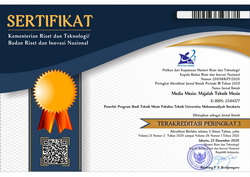EFFECT OF LONGITUDINAL FEEDS ON FLAT GRINDING PROCESSES ON VIBRATION AND SURFACE ROUGHNESS IN OCR12VM MATERIAL
Kurnia Dwi Artika(1*), Suhardjono Suhardjono(2), Yuliana Ningsih(3)(1) Program Studi Teknologi Otomotif Politeknik Negeri Tanah Laut
(2) Fakultas Teknik Industri, Jurusan Teknik Mesin Institut Teknologi Sepuluh Nopember Surabaya
(3) Program Studi Teknologi Otomotif Politeknik Negeri Tanah Laut
(*) Corresponding Author
Abstract
The grinding process is machining to achieve a high-quality surface finish and high dimensional accuracy. There are two primary processes, the roughing and finishing process. The roughing process generates higher dynamic cutting forces than the finishing process. It leads to a higher vibration that reduces the ground surface quality, tends to lower dimensional accuracy, and shortens the grinding wheel life. On the other hand, the roughing process is applied to reduce machining time, increasing productivity. We conducted this research to study the effect of longitudinal feed on vibration and the surface roughness of hardened tool steel OCR12VM (equivalent to JIS SKD 11), machined by the surface grinding process. The longitudinal feed was varied from 100 mm/s up to 250 mm/s with a 50 mm/s increment. Each variation was machined with a depth of cut of 0.01 mm, 0.02 mm and 0.03 mm, respectively. The constant machining parameter was set: n= 3000 rpm, transversal feeding= 0.04 mm/stroke. The dimension of the grit 80 Aluminium oxide grinding wheel= Ø 200 mm x 25 mm. The result of the research showed that the surface roughness of the ground surface was linearly proportional to the RMS vibration level. The longitudinal feed effects that increased feed resulted from higher surface roughness. The roughness data trend line on the surface has a square function to the longitudinal feed. The similarity, as previously mentioned, is that the vibrations level also increases quadratically with increasing the longitudinal feed. Thus, it is evident that the surface roughness of the ground surface is closely related to the vibration level during the grinding process. Based on this result, it can predict the roughness of the ground surface by measuring the vibration level during the grinding process without measuring the surface roughness.
Keywords
Full Text:
PDFReferences
J. Gradišek, A. Baus, E. Govekar, F. Klocke, and I. Grabec, “Automatic chatter detection in grinding,” Int. J. Mach. Tools Manuf., vol. 43, no. 14, pp. 1397–1403, Nov. 2003, doi: 10.1016/S0890-6955(03)00184-6.
T. Tawakoli and A. Vesali, “Dynamic behavior of different grinding wheel hub material in high efficiency deep grinding (HEDG),” ASME Int. Mech. Eng. Congr. Expo. Proc., vol. 3, no. PARTS A, B, AND C, pp. 1913–1919, 2012, doi: 10.1115/IMECE2012-86207.
I. Inasaki, B. Karpuschewski, and H. S. Lee, “Grinding chatter - Origin and suppression,” CIRP Ann. - Manuf. Technol., vol. 50, no. 2, pp. 515–534, 2001, doi: 10.1016/S0007-8506(07)62992-8.
H. Li and Y. C. Shin, “Wheel regenerative chatter of surface grinding,” J. Manuf. Sci. Eng. Trans. ASME, vol. 128, no. 2, pp. 393–403, May 2006, doi: 10.1115/1.2137752.
M. Leonesio, P. Parenti, A. Cassinari, G. Bianchi, and M. Monno, “A time-domain surface grinding model for dynamic simulation,” 2012, doi: 10.1016/j.procir.2012.10.030.
J. A. Schey, Introduction to manufacturing processes/ Schey. New York: McGraw-Hill Books Co, 1977.
F. (Franz) Koenigsberger and J. Tlustý, Machine tool structures. Pergamon Press, 1969.
T. ROCHIM, PROSES PEMESINAN BUKU 4 : PROSES GERINDA. ITB, 2007.
Kjaer; Bruel;, “Measuring Vibration,” Office, 1982, doi: 10.1017/CBO9781107415324.004.
L. Meirovitch, M. International, W. T. Thomson, and S. G. Kelly, Fundamentals of Vibrations. Mc Graw Hill, 2001.
C. W. De Silva, Vibration : Fundamental and Practice. CRC Press, 1999.
X. Zhou and F. Xi, “Modeling and predicting surface roughness of the grinding process,” Int. J. Mach. Tools Manuf., 2002, doi: 10.1016/S0890-6955(02)00011-1.
Article Metrics
Abstract view(s): 968 time(s)PDF: 579 time(s)
Refbacks
- There are currently no refbacks.








